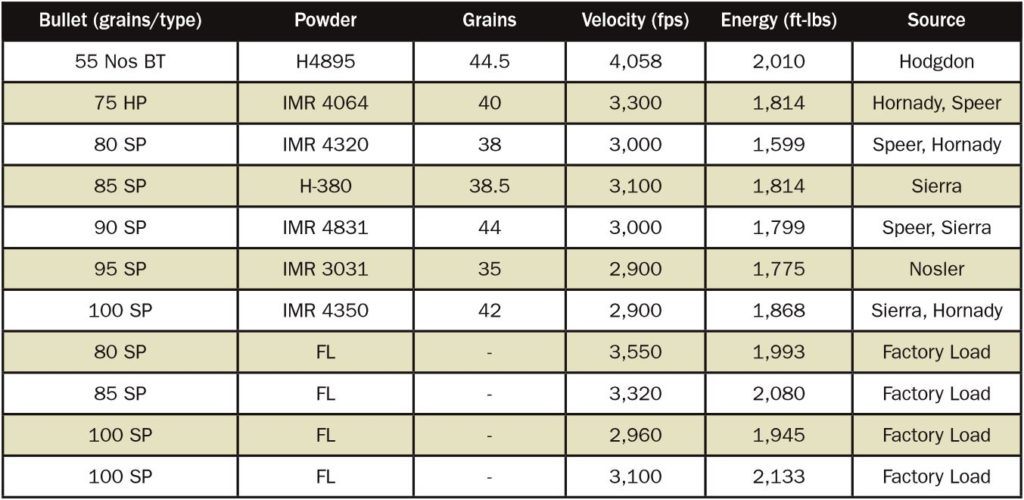
Developed to handle everything from varmints to medium game, the .243 Winchester remains a flexible and accurate 6mm option.
What You Need To Know About The .243 Winchester:
- The .308 Winchester provides the parent case.
- Next to .30-06, probably chambered in more rifles than any other cartridge.
- With mono-metal bullets, appropriate for big game.
 The .243 Winchester was introduced by Winchester in 1955 for its Model 70 bolt-action and Model 88 lever-action rifles. The .243 Win. was quickly adopted by Savage for its Model 99 lever- and Model 110 bolt-action rifles. All the British and European manufacturers soon began chambering bolt-action rifles for this round. In fact, even Remington, which developed its own 6mm, had to recognize the popularity of the .243 and start chambering its rifles for it.
The .243 Winchester was introduced by Winchester in 1955 for its Model 70 bolt-action and Model 88 lever-action rifles. The .243 Win. was quickly adopted by Savage for its Model 99 lever- and Model 110 bolt-action rifles. All the British and European manufacturers soon began chambering bolt-action rifles for this round. In fact, even Remington, which developed its own 6mm, had to recognize the popularity of the .243 and start chambering its rifles for it.
The .243 (6mm) Winchester is nothing more than the .308 Win. case necked down. Original development and publicity was due largely to the efforts of one gun writer, the late Warren Page, who, along with other wildcatters, worked out a similar version before Winchester. The .243 Win. is probably chambered in more different rifles than any other cartridge, except possibly the .30-06 Springfield, which is no surprise. The .243 Winchester represents a successful effort to develop a light deer rifle cartridge that could hold its own with the high-velocity .22s for long-range use on small targets — and still be adequate for larger animals. The .243 Win. does this job well. It eliminates the need to own two different rifles for anything from small game and pests up to and including deer and antelope.
The 80-grain bullet is intended primarily for varmint and small game, and the 100-grain bullet is ideal for deer-size animals. The .257 Roberts and the .250-3000 Savage are supposed to cover the same range and certainly do. All major domestic and overseas manufacturers of commercial ammunition offer this caliber. Its popularity as a deer caliber has prevailed over its varmint capabilities. (Editor’s note: The .243 Win. has garnered a reputation among ballisticians for erratic performance. Handloaders should keep this firmly in mind.) In a 2000 press release, Remington announced the availability of electronic ignition .243 Winchester ammunition for use in its new (and now defunct) EtronX rifle. The initial loading uses a 90-grain Nosler Ballistic Tip bullet. Owing to the unique primer, this ammunition will not work in a conventional rifle (just as conventional ammunition will not work in the EtronX rifle). Except for the primer, this ammunition uses conventional components.
More Ammunition Information:
- The Blistering Hot 30 Nosler
- The .280 Ackley Improved
- If You Had To Pick Just One Cartridge, What Would It Be?
- Loading the .308 Winchester
Update: The recent introduction of all-copper, mono-metal bullets, such as the Barnes Triple-Shock and Tipped Triple-Shock, the Hornady GMX and the Lapua Naturalis, allow the .243 Winchester, as well as other 6mm cartridges that produce the same or higher velocities, to be very effective on big game while using a faster and lighter bullet. Additionally, Frank Barnes mentioned the erratic performance handloaders could expect when working with the .243 Winchester; while this has become an ever-persistent warning with this cartridge, many handloaders have been building the .243 Winchester for 20-plus years and find it as easy to work with as any other cartridge.

Editor's Note: This article originally appeared in the October 2018 issue of Gun Digest the Magazine.

Next Step: Get your FREE Printable Target Pack
Enhance your shooting precision with our 62 MOA Targets, perfect for rifles and handguns. Crafted in collaboration with Storm Tactical for accuracy and versatility.
Subscribe to the Gun Digest email newsletter and get your downloadable target pack sent straight to your inbox. Stay updated with the latest firearms info in the industry.

![Best Concealed Carry Guns In 2025 [Field Tested] Wilson Combat EDC X9S 1](https://gundigest.com/wp-content/uploads/Wilson-Combat-EDC-X9S-1-324x160.jpg)


![Best 9mm Carbine: Affordable PCCs [Tested] Ruger Carbine Shooting](https://gundigest.com/wp-content/uploads/Ruger-Carbine-Shooting-100x70.jpg)
![Best AR-15: Top Options Available Today [Field Tested] Harrington and Richardson PSA XM177E2 feature](https://gundigest.com/wp-content/uploads/Harrington-and-Richardson-PSA-XM177E2-feature-100x70.jpg)
